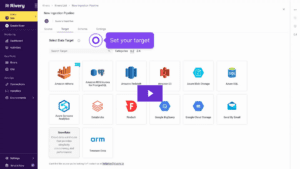- Product
- Solutions
Data Management & ELT Glossary
Key terms to help you learn more about data management, ELT, and all-things RiveryAll A B C D E F G H I J K L M N O P Q R S T U V W X Y ZAAPI (Application Programming Interface)An API (Application Programming Interface) is a software interface that relays information between two different software applications.
Read More >BBig DataBig data refers to extremely large, overwhelming volumes of data that are too massive to be organized and analyzed using traditional methods.
Read More >Big Data AnalyticsBig data analytics applies advanced analytic methods and tools to exceptionally large data sets to uncover patterns, correlations, and other insights.
Read More >Big Data AutomationBig data automation refers to technologies that automate the processes and tasks associated with gathering, maintaining, and analyzing big data.
Read More >Big Data SecurityBig data security is the process of securing vast quantities of data through advanced methods and expanded security capabilities.
Read More >Business IntelligenceBusiness intelligence (BI) utilizes software and technology to help companies improve decision-making through actionable data.
Read More >CCloud ComputingCloud computing is a technology that enables users to store and access data through the internet or remote data centers instead of hosting the data on on-premise hardware.
Read More >Cloud IntegrationCloud integration is a form of technology that integrates and combines cloud-based systems into a unified whole.
Read More >Columnar DatabaseColumnar databases are database management systems (DBMS) that store data in columns instead of rows.
Read More >Critical DataCritical data is information that an organization or company decides is necessary for successful operations.
Read More >DData AccessData access is the authorized permission and ability to collect, inspect, adjust, copy, and transfer data from IT systems.
Read More >Data AggregationData aggregation is the general process where data or information is collected and then summarized in a simplified form.
Read More >Data AnalyticsData analytics is the process of investigating, cleaning, transforming, and modeling data to uncover useful insights and inform decision-making.
Read More >Data BlendingData blending combines different sets of data, from multiple sources, into a new, single data set.
Read More >Data CleansingData cleansing is the process of adjusting or removing data that is improperly formatted, irrelevant, incomplete, or otherwise incorrect.
Read More >Data EngineerA data engineer builds, deploys, and maintains the organization’s data infrastructure.
Read More >Data HarmonizationData harmonization merges data from different sources into a unified view that can be utilized in multiple ways, by multiple people.
Read More >Data OrchestrationIn essence, the term refers to the process of harvesting big data from a variety of data-storing locations for the purpose of combining and organizing it
Read More >EELTExtract, Load, Transform "ELT" is a modern variant of traditional "ETL", where extracted data is loaded into a target database in its original raw format before any data transformation takes place.
Read More >ETL"ETL" is a common computing procedure, which stands for "Extract, Transform, and Load." "ETL" is used when you have multiple data sources that you want to bring into a centralized database for querying/analysis.
Read More >
